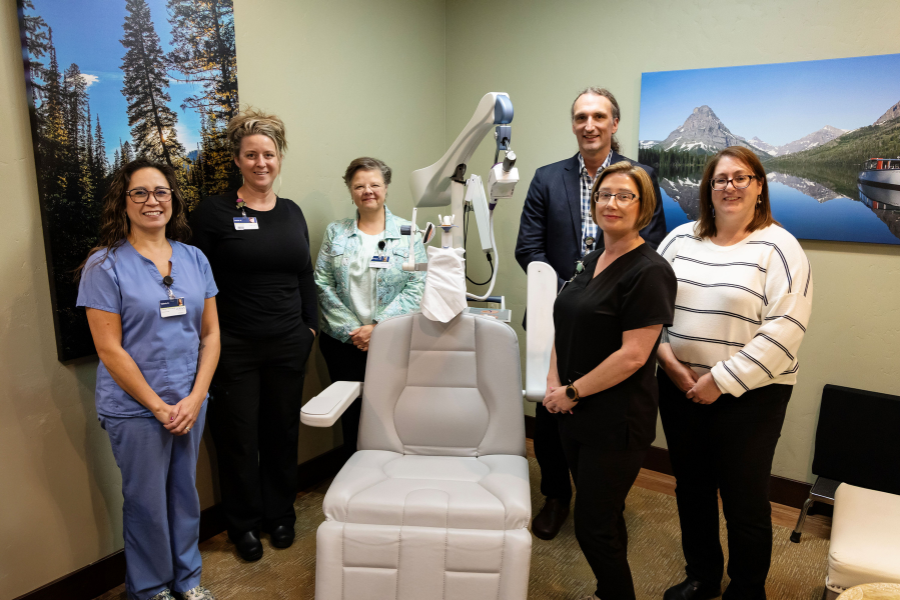When Logan Health – Whitefish psychiatrist Doug Muir, MD, began treating patients with depression with Transcranial Magnetic Stimulation (TMS) in 2019, it was little-known, yet cutting-edge technology.

The TMS team at Logan Health Behavioral Health – Whitefish. Pictured left to right Val Norton, Lexie Gearhart, Dr. Myers, Mr. Muir, Callie Scheeler, Jenifer Lewis. Not pictured: Trevor Erickson.
Looking for an alternative for people who have tried multiple antidepressant medications without satisfaction or success, Dr. Muir appealed to the hospital foundation to purchase a TMS system, the first in the valley. Due to increased need to improve access to mental health and lower the number of suicide attempts, the foundation board launched a campaign and funded the system through community donations.
Montana has consistently been ranked as a state with one of the highest rates of suicide and depression in the nation, and the demand for the service has grown such that a second TMS system was added to the clinic in 2023.
In addition to adding a second TMS system and doubling the clinic’s capacity, the clinic also welcomed new providers Ruth Myers, MD, and Jennifer Lewis, PMHNP-BC, who specialize in psychiatry and mental health, last fall. The TMS team also includes lead nurse, Valerie Horton and medical assistants Callie Scheeler, Lexie Gearhart and Trevor Erickson.
What is TMS and how does it work?
TMS uses magnetic pulses, like an MRI machine, to stimulate nerve cells in specific areas in the brain to improve their function, which has significantly reduced depression symptoms.
Imagine a recliner similar to what you might find in your own living room. On a TMS machine, a mechanical arm extends above the reclining chair. At the end of the arm is a device containing magnetic coils. The patient sits while a TMS nurse or medical assistant performs the treatment, moving the device on the patient’s head and targeting the areas of the brain associated with depression. Patients feel a tapping on their head, followed by a pause. The treatment lasts 20 minutes or less.
“Patients report feeling subjectively better after a session and we monitor this with depression and anxiety scales weekly,” said Dr. Muir. “If anyone has struggled with depression for any amount of time it’s unrealistic to think they’ll have zero symptoms however, they could have 95-percent reduction.”
In the first three years, Logan Health Behavioral Health – Whitefish treated 120 patients with TMS. Patients have claimed that it has been life-changing and even lifesaving.
One patient tried it after an unsuccessful suicide attempt. With every treatment, the patient felt progress and looked forward to each treatment. After completion of the series, the patient was able to return to work and other activities enjoyed before the patient’s depression.
Another patient that suffered from depression and anxiety considered suicide and then heard about TMS. After years of trying almost every antidepressant on the market, TMS was the treatment that made a difference. The patient reported feeling more energetic with an increased ability to control their emotions, a change also noticed by the patient’s family members.
“Anyone with severe depression, anxiety obsessive compulsive disorder that are not getting good results or benefits from medications and would like to try a nonmedication option, TMS is an option,” added Dr. Myers.
After a referral from a primary care provider, patients can see one of our providers at Logan Health Behavioral Health – Whitefish for an initial consultation. After authorization, the patient will receive sessions for five days a week for six weeks. Once the initial sessions are completed, sessions will be tapered to three days a week for two weeks. Each session lasts ten to forty minutes.
To learn more about TMS services offered at Logan Health Behavioral Health – Whitefish, call (406) 862-1030.
